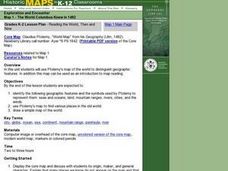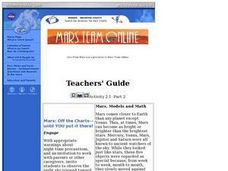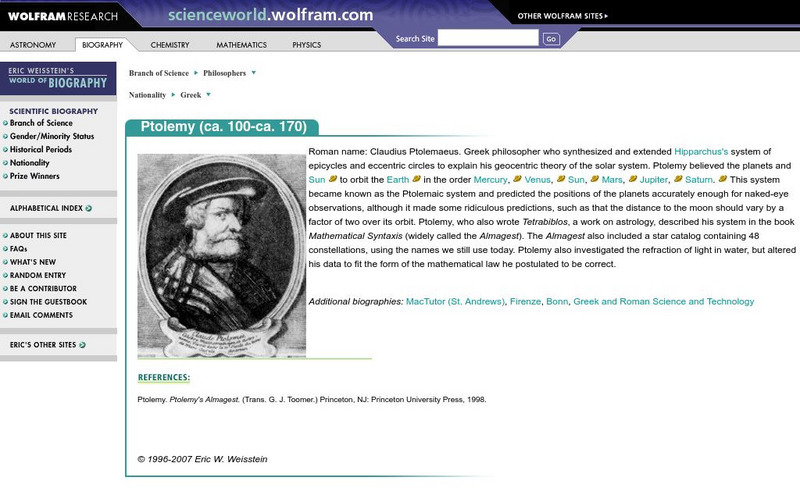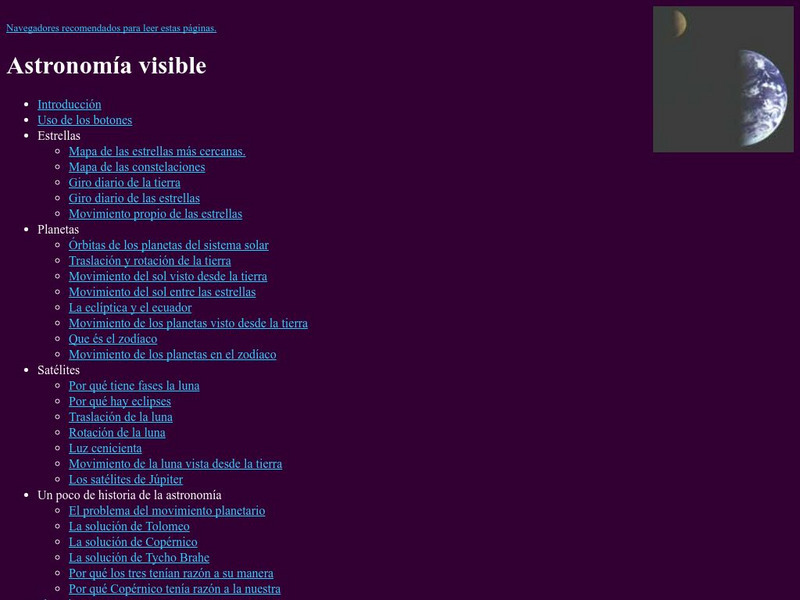EngageNY
Ptolemy's Theorem
Everyone's heard of Pythagoras, but who's Ptolemy? Learners test Ptolemy's Theorem using a specific cyclic quadrilateral and a ruler in the 22nd installment of a 23-part module. They then work through a proof of the theorem.
Mr. E. Science
Our Solar System
The presentation starts with the scientists who made discoveries about our solar system: Ptolemy, Copernicus, Galileo, Brahe, Kepler, and Newton. It also covers the planets, inner, outer, and Pluto, satellites, and an in-depth discussion...
Curated OER
Astronomy - Ancient Philosophies
Combine science and social studies with this collection of notes on ancient astronomy. Ideas propagated by early scientists influenced the way people viewed life and our place in the universe. Examine the philosophies of Aristotle,...
Curated OER
Theories
Students view a series of videos that explore the development, formation and arguments for the geocentric model of the solar system. Studenst investigate the heliocentric model of the solar system and consider how scientific theories...
Curated OER
The Great Lighthouse at Alexandria
Students read and research about Alexandria's Great Lighthouse. In this Greek architecture lesson, students create a timeline of events in Alexandria, and design a lighthouse. Students research lighthouses online and write a report.
Curated OER
Ptolemy, Copernicus, & the Church
Students explore the scientific revolution. In this scientific revolution lesson, students complete activities regarding Ptolemy, Copernicus, and the Church.
Curated OER
Solar System Vocab Word Search
In this science worksheet, learners locate and identify various vocabulary terms related to space science. There are 21 words located in the puzzle.
Curated OER
Ptolemy vs. Copernicus
Students list differences in the diagrams of a geocentric universe and a heliocentric universe. They students describe the religious impact of this change on man's conception of the universe and man's place within it. Students describe...
Curated OER
Ptolemy, Copernicus, & the Church
High schoolers determine the difference between a geocentric universe and a heliocentric universe.
Curated OER
Reading the World, Then and Now
Students distinguish geographic features using Ptolemy's map of the world.
Curated OER
History of Astronomy
Students participate in assessments regarding the history of astronomy. They listen and take notes, draw a time line, draw a solar sytem designed by Ptolemy and create flashcards. They write an essay on Galileo, watch a video, take a...
Curated OER
Mars: Off the Charts--Until You Put It There
Learners explore the night sky and make illustrations which are shared in class the next day. Distinctions are made between the stars and the planets and views of the constellations for the season are made available. The work of early...
Curated OER
Columbian Contexts
Students explore geo-political and economic contexts for the European Renaissance journeys of exploration, including those of Columbus, create cartographic symbols, and add those symbols to a print-out of Ptolemy's map.
University of Oregon
University of Oregon: Greek Science: Early Cosmology
Discusses the evolution of ideas about the cosmos, from the Magic Cosmology of the Neolithic age to the stage of Mythical Cosmology, to the Geometric Cosmology of the ancient Greeks. The third stage advocated a rational approach to...
World Wide School
World Wide School: Chapter X: Science of the Roman Period
A description of the lack of original Roman science, focusing on the influence of Greek ideas and concepts on the Romans. Click on 'Next' at the end of the text to continue for four more pages on this topic. These talk about Strabo the...
American Association of Physics Teachers
Com Padre Digital Library: Open Source Physics: Inferior Ptolemaic Model
This simulation offers an illustration of Ptolemy's orbit for an inferior planet.
Other
Alexandria: A Historical Outline
The Hellenic Electronic Center offers extensive information about Alexandria starting with its founding by Alexander to contemporary times. Describes the achievements of the city and its decline because of other sea routes for trade.
University of St. Andrews (UK)
University of St. Andrews: Francois Viete
The University of St. Andrews offers this iography of Francois Viete. Many links are provided for more information.
ibiblio
Ibiblio: Ptolemy's Geography
Brief discussion about Ptolemy's geography. Includes pictures of publications from ancient Greece based on Ptolemy's beliefs.
ibiblio
Ibiblio: Expanding Horizons
IBiblio.org offers insight to the science, beliefs, and technologies of 15th and 16th century Europeans. Provides excellent images and examples.
Rice University
Galileo Project: The Ptolemaic System
This site from The Galileo Project of Rice University provides this discourse on the Ptolemic System that attempted to explain the motion of heavenly bodies. Pictures, charts, and links are all provided for additional information.
Wolfram Research
Wolfram Science World: Ptolemy (Ca. 100 Ca. 170)
A very brief description of Ptolemy's role in researching astronomy. Links to related information.
Wikimedia
Wikipedia: Ptolemy
A biography on Ptolemy, a Greek astronomer, discusses his two most famous works, "Almagest" and "Geographia." Other books he wrote are also listed.
Ministerio de Educación (Spain)
Ministerio De Educacion: Astronomia Visible
This site has maps of the nearest stars and constellations. Earth and star daily rotation, proper motion of the stars and many other topics about the solar system are also shown.Read phonetically

























